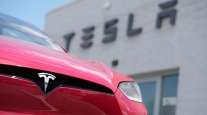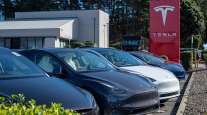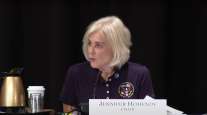Bloomberg News
NTSB Critical of Tesla, Apple in Probe of 2018 Crash

[Stay on top of transportation news: Get TTNews in your inbox.]
The 2018 fatal crash of a Tesla Inc. SUV, in which an Apple Inc. employee was playing a game on his company-issued phone and the car veered into a divider, highlights the “misuses of technology,” a U.S. investigator said Feb. 25.
Not only did the driver allow the semi-autonomous driving system in the Tesla vehicle to essentially drive itself, but Apple didn’t instruct its employees not to use its devices while behind the wheel, said National Transportation Safety Board Chairman Robert Sumwalt.
“The crash driver’s employer, Apple, is a tech leader, but like most employers, has yet to develop a distracted driving policy,” Sumwalt said in an opening statement at the NTSB’s meeting to conclude the cause of the accident.
Sumwalt also had harsh words for Tesla, which he said has ignored the NTSB’s calls for the company to equip its vehicles with better safeguards to prevent drivers from misusing systems that provide limited automation. He said auto safety regulators have provided little oversight of the technology and also ignored recommendations to improve the safety of those systems.
Host Seth Clevenger went to CES 2020 in Las Vegas and met with Rich Mohr of Ryder Fleet Management Solutions and Stephan Olsen of the Paccar Innovation Center to discuss how high-tech the industry has become. Listen to a snippet above, and to hear the full episode, go to RoadSigns.TTNews.com.
The NTSB, which has for years issued warnings about distracted driving and its deadly toll on the roadways, asked Apple last year whether it has taken steps to ensure employees don’t misuse their devices.
Sumwalt reiterated the NTSB’s recommendations from 2011 calling on the technology industry to develop automated protections to prevent misuse of electronic devices by drivers.
The death of 38-year-old Apple engineer Walter Huang in March 2018 in Silicon Valley has put a spotlight on the carmaker, the driver and California authorities who failed to repair the highway barrier he struck after a prior crash. Now the attention is also turning to makers of the mobile devices that have become a growing hazard on the roads.
The NTSB posted a document on Feb. 24 in its public record on the crash showing Apple didn’t have a policy on distracted driving.
“I checked around with various groups and we do not have a policy related to phone use and driving,” wrote an Apple representative in an email response to the NTSB, which was posted to the safety board’s public investigative files on Feb. 24.
An Apple spokesman said the company expects its employees to follow the law.
The NTSB is meeting to conclude what caused the crash into a concrete highway barrier at about 70 miles per hour and to issue recommendations to help prevent such crashes in the future.
Public files indicate the crash followed a variety of missteps and errors. The car’s automated driving system veered into the barrier. The driver, who didn’t have his hands on the wheel, had been playing a game on his phone. And a protective barrier on the highway wasn’t in place.
In addition, Tesla and government agencies haven’t bothered to respond to NTSB’s recommendations related to an earlier, similar crash. The U.S. Department of Transportation is required by law to respond to NTSB recommendations, but didn’t do so after the earlier crash, NTSB records show.
The crash also focuses on a long-standing concern by the NTSB and highway safety advocates that there should be technological solutions to the growing problem of distracted driving.
The NTSB in 2011 urged two trade associations for consumer electronics makers and wireless service providers to encourage the development of systems to disable mobile devices within the reach of a driver while a vehicle is in motion. The agency said at the time that such a feature should allow drivers to use the device in an emergency and to distinguish between drivers and passenger.
In response, Consumers Electronics Association President Gary Shapiro told the NTSB in 2012 that the group supported prohibiting text messaging while behind the wheel, though it disagreed that a ban on non-emergency use of mobile devices while driving was warranted.
Smartphone manufacturers and software developers have taken some steps to address distracted driving. Apple’s iPhone, for example, has a feature to block text message and other notifications when driving that a user can activate in the phone’s settings.
“The challenge is that they’re all passive systems. They require you as the owner of the phone to take that action, and many won’t or don’t because they don’t have to,” said Kelly Nantel, vice president of roadway safety at the National Safety Council.
Want more news? Listen to today's daily briefing:





